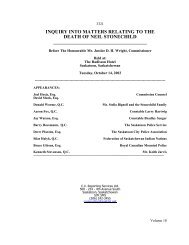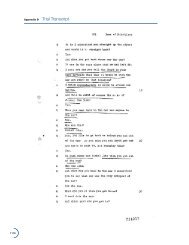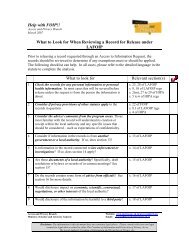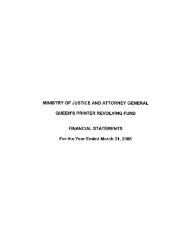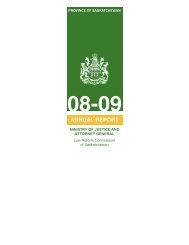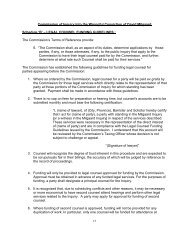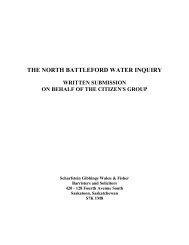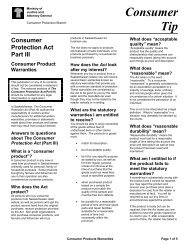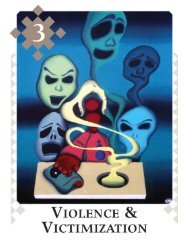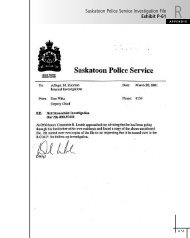Appendix K Memorandum of Law - s. 9(2) of the Canada Evidence Act
Appendix K Memorandum of Law - s. 9(2) of the Canada Evidence Act
Appendix K Memorandum of Law - s. 9(2) of the Canada Evidence Act
You also want an ePaper? Increase the reach of your titles
YUMPU automatically turns print PDFs into web optimized ePapers that Google loves.
<strong>Appendix</strong> K <strong>Memorandum</strong> <strong>of</strong> <strong>Law</strong><br />
Justice Roach wrote a dissenting opinion which followed Greenough v. Eccles. His judgment is important<br />
because a dissenting member <strong>of</strong> <strong>the</strong> Supreme Court <strong>of</strong> <strong>Canada</strong> endorsed it on appeal. 41 It states as<br />
follows:<br />
Both [section 24 <strong>of</strong> <strong>the</strong> Ontario <strong>Evidence</strong> <strong>Act</strong> and section 9 <strong>of</strong> <strong>the</strong> CEA] have been adopted from <strong>the</strong> Common<br />
<strong>Law</strong> Procedure <strong>Act</strong>, in England, 1854, 17 & 18 Vict., c. 125, s. 22. That <strong>Act</strong> was <strong>the</strong> result <strong>of</strong> a report made by<br />
<strong>the</strong> Common <strong>Law</strong> Practice Commissioners in 1853.<br />
…<br />
It is important to keep in mind what <strong>the</strong> law in England was at <strong>the</strong> time <strong>the</strong> Common <strong>Law</strong> Practice<br />
Commissioners made <strong>the</strong>ir report and up to <strong>the</strong> enactment <strong>of</strong> <strong>the</strong> Common <strong>Law</strong> Procedure <strong>Act</strong> in 1854. If a<br />
witness called by one <strong>of</strong> <strong>the</strong> parties, in <strong>the</strong> opinion <strong>of</strong> <strong>the</strong> trial Judge, was hostile, leave might be given by <strong>the</strong> trial<br />
Judge to cross-examine him. That was one <strong>of</strong> <strong>the</strong> rules <strong>of</strong> evidence that had grown up in England as <strong>the</strong> result<br />
<strong>of</strong> practice so as to become <strong>the</strong> law <strong>of</strong> <strong>the</strong> land. As far as I know <strong>the</strong>re was no statutory authority for <strong>the</strong> rule.<br />
Even today <strong>the</strong>re is no statutory authority for <strong>the</strong> rule in this Province and yet it is a well recognized rule. We in this<br />
Province did not create it; we adopted it or inherited it. The rule applied <strong>the</strong>n, as it applies now, to any witness<br />
called by a party and who proved hostile to <strong>the</strong> party calling him. “Hostile” had a very particular meaning. For <strong>the</strong><br />
moment it will suffice to say that it did not mean merely ‘unfavourable’. The rule applied to any witness called by<br />
a party and who proved hostile and with respect to whom leave to cross-examine was granted by <strong>the</strong> trial Judge.<br />
What had been doubted prior to <strong>the</strong> Common <strong>Law</strong> Procedure <strong>Act</strong> was whe<strong>the</strong>r in addition to cross-examining<br />
that witness affirmative evidence could be adduced that he had made a prior inconsistent statement. The <strong>Act</strong><br />
was aimed at <strong>the</strong> witness who not only was hostile but had also made a prior inconsistent statement. The statute<br />
did not use <strong>the</strong> word ‘hostile’; it used <strong>the</strong> word ‘adverse’.<br />
…<br />
The decisions in England subsequent to Greenough v. Eccles have been divers. They have been collected<br />
in <strong>the</strong> third edition <strong>of</strong> Wigmore on <strong>Evidence</strong>, Vol. III, in note 2 to s. 905, pp. 402-3. Without here reviewing<br />
<strong>the</strong>m, it will suffice to say that in my respectful opinion <strong>the</strong> great weight <strong>of</strong> authority in England supports <strong>the</strong><br />
interpretation given in <strong>the</strong> Greenough case [i.e., that <strong>the</strong> witness must be shewn to be ‘hostile’ before he can be<br />
cross‐examined by <strong>the</strong> party calling him]. 42<br />
Justice Roach <strong>the</strong>n went on to consider <strong>the</strong> procedure for determining ‘adversity’ under <strong>the</strong> statute.<br />
In doing so, he reviewed Hannigan 43 and Hunter 44 and stated as follows:<br />
The next question is, – how is hostility determined? Until that question cropped up in this case I did not think<br />
<strong>the</strong>re was any doubt as to how it would be determined. It would be determined, so I thought and still think, by <strong>the</strong><br />
Judge observing <strong>the</strong> witness as he gave his evidence in <strong>the</strong> witness-box, his demeanor and his general attitude<br />
and <strong>the</strong> substance <strong>of</strong> his evidence. It is now said that, in addition to <strong>the</strong> indicia which <strong>the</strong> trial judge would have<br />
available to him from that source, it would be proper to place before him in evidence on a voir dire <strong>the</strong> fact that<br />
<strong>the</strong> witness had made on some earlier occasion a statement inconsistent with his <strong>the</strong>n evidence. My attention<br />
has been called to two cases that support that proposition: The People (Attorney-General) v. Hannigan, in <strong>the</strong><br />
Court <strong>of</strong> Criminal Appeal in Ireland, [1941] Ir. R. 252, and R. v. Hunter, a decision <strong>of</strong> <strong>the</strong> Full Court <strong>of</strong> <strong>the</strong> Supreme<br />
Court <strong>of</strong> Victoria, [1956] V.L.R. 31. I propose to respectfully analyze those decisions because, <strong>the</strong>re being no<br />
decision to <strong>the</strong> contrary binding on this Court, I think it would be open to this Court to adopt <strong>the</strong> reasoning in<br />
those cases if we find <strong>the</strong>m persuasive.<br />
…<br />
41 Justice Cartwright endorsed Justice Roach’s judgment at <strong>the</strong> Supreme Court: see Wawanesa (SCC), supra note<br />
21 at pp. 165 to 174. However, Justice Cartwright was <strong>the</strong> lone dissenter in that decision and <strong>the</strong> only Justice to<br />
consider <strong>the</strong> issue <strong>of</strong> ‘adversity’ and s. 24 <strong>of</strong> Ontario’s <strong>Evidence</strong> <strong>Act</strong>.<br />
42 Wawanesa (OCA), supra note 21 at pp. 195 and 199 to 200.<br />
43 Hannigan, supra note 29.<br />
44 Hunter, supra note 30.<br />
2586



